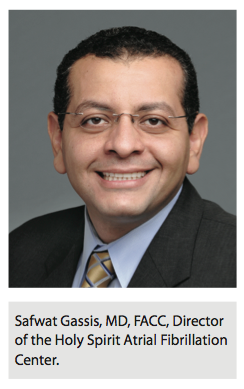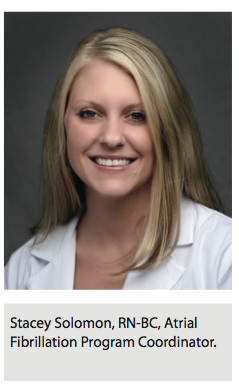ADVERTISEMENT
Atrial Fibrillation Support Group at Holy Spirit/A Geisinger Affiliate
In this feature interview we speak with Atrial Fibrillation Program Coordinator Stacey Solomon, RN-BC about the Atrial Fibrillation Support Group at Holy Spirit/A Geisinger Affiliate in Camp Hill, Pennsylvania.
How did this atrial fibrillation (A-Fib) support group come about? When was it formed? Does your support group have a name or nickname?
Safwat Gassis, MD, FACC, Director of the Holy Spirit Atrial Fibrillation Center, founded the support group in April 2013. We recognized a need for more public awareness about this common arrhythmia, which can have a significant impact on patients’ quality of life, stroke risk, and risk for heart function deterioration. A-Fib is increasing in prevalence, and the treatment options are growing more complex.
Tell us about your role in the support group. How did you become involved?
I am a registered nurse and the Program Coordinator of the Atrial Fibrillation Center. My background helps to create a multidisciplinary approach for education and learning. Dr. Gassis, Dr. David Man (Director of the HoIy Spirit Electrophysiology Lab), and I moderate discussions about the impact A-Fib can have on quality of life and also review the pathophysiology of A-Fib. It’s important for patients to understand causes and symptoms so they can recognize when it is not adequately controlled. The purpose of the support group is to provide general education to the public as well as a relaxed environment for people to gain support from those who share similar challenges. We invite guest speakers from various disciplines to discuss the impact A-Fib can have on overall health and well-being. Specialists from other disciplines explain how A-Fib is associated with other medical  conditions (such as obesity, diabetes, lung disease, stroke, or heart failure) and lifestyle decisions (such as tobacco and alcohol use).
conditions (such as obesity, diabetes, lung disease, stroke, or heart failure) and lifestyle decisions (such as tobacco and alcohol use).
When and how often does this support group meet? Where do meetings take place?
Meetings are scheduled approximately every three months in the hospital auditorium. This provides a central location for attendees and enough space to accommodate larger groups when needed. This location allows us to illustrate some of the more complex concepts related to A-Fib and its management in a simplified format using audiovisual presentations.
How many group participants are there generally? Do you find the same patients generally attend each meeting, or does the group consist mainly of new patients each time? What is the age range of the participants?
Typically, we see between 10-45 attendees for each session — this includes a combination of new participants and those known to our group. A-Fib, although more common in the elderly, can be diagnosed at any age; however, the age range has been between 40-85 years of age. Family members and caregivers of patients with A-Fib have also found these sessions particularly useful, since A-Fib not only has an impact on the life of the  patient, but a significant impact on family members as well.
patient, but a significant impact on family members as well.
What is a typical meeting like? How long does each meeting last? Tell us more about the multidisciplinary approach used to guide discussions.
Meetings are conducted in a relaxed environment that encourages participation from the attendees. Typically, educational and interactive slides are presented, which facilitate discussion between participants and moderators. The discussion is interactive, and we pose questions to the attendees to determine their knowledge about A-Fib as well as discuss common misconceptions. Attendees are encouraged to share their own experiences, frustrations, and anxieties to help gain support from one another. Each meeting is approximately 1.5 hours long. Discussions include the pathophysiology of A-Fib, treatment options, and stroke risk management, which is presented by Dr. Gassis. Dr. Man reviews anticoagulation, antiarrhythmics, and options for left atrial appendage management. Additionally, I discuss the impact A-Fib can have on one’s quality of life, useful lifestyle modifications, and how to recognize when the rhythm is not adequately controlled. We invite guest speakers, such as behavioral health experts, to review coping mechanisms when dealing with stress and different problem solving skills to gain insight about strategies to cope with the disease. (Holy Spirit/A Geisinger Affiliate also offers the Spirited Heart’s Cardiac Support Group for patients and family members living with heart disease).
What are some of the common anxieties or issues that you hear from patients? How do you help patients manage these anxieties?
Common anxieties from patients include fear of having a stroke or heart attack, and in some instances, fear of death. Many patients feel overwhelmed by the treatment plan, and are frustrated if initial treatment options fail. We encourage attendees to discuss their anxieties and ask questions. Attendees learn the differences between paroxysmal, persistent, and permanent A-Fib, recognizing that treatment is very different for each. Taking anticoagulants and antiarrhythmic drugs can cause stress for some patients. We present factual information in a relaxed setting to address common misconceptions related to the heart rhythm and treatment options. Having a broader understanding of A-Fib can help tremendously alleviate fears. The behavioral health team educates the attendees on coping techniques such as cognitive and emotional appraisal, perceived understanding of the illness, and the understanding of level of disruption in one’s life due to complexity of the treatment plan. Once patients understand how they view their illness and utilize these coping techniques, they are better able to overcome the challenges faced during treatment and can more readily identify solutions to improve their quality of life.
encourage attendees to discuss their anxieties and ask questions. Attendees learn the differences between paroxysmal, persistent, and permanent A-Fib, recognizing that treatment is very different for each. Taking anticoagulants and antiarrhythmic drugs can cause stress for some patients. We present factual information in a relaxed setting to address common misconceptions related to the heart rhythm and treatment options. Having a broader understanding of A-Fib can help tremendously alleviate fears. The behavioral health team educates the attendees on coping techniques such as cognitive and emotional appraisal, perceived understanding of the illness, and the understanding of level of disruption in one’s life due to complexity of the treatment plan. Once patients understand how they view their illness and utilize these coping techniques, they are better able to overcome the challenges faced during treatment and can more readily identify solutions to improve their quality of life.
What is the most memorable story you’ve heard from a patient?
The most memorable story I’ve heard was from the wife of a patient who was in the process of adjusting his treatment plan for his A-Fib. His symptoms were debilitating at times and were beginning to affect his happiness, energy level, and the relationship with his family. This couple had been to a few meetings, hoping to learn about treatment options and coping strategies. After a few sessions, the wife approached us, thanking us for educating her about her husband’s symptoms and helping her understand why he is, at times, so limited. This was an enormous source of stress for their family. She gained more insight into the challenges and limitations he is facing on a daily basis. Her awareness of these challenges allowed the couple to cope with the disease, improve their quality of life, and have a better understanding of his health condition.
How do you address the issue of phantom shocks?
In particular, we discuss how A-Fib, if poorly controlled in patients with an ICD, can result in a shock. Regular ICD checks through their doctor’s office can provide reassurance. Additionally, we explain that an ICD shock, in most instances, is not a subtle experience, and in the event they think a shock occurred, to call their doctor’s office. The repetitive reassurance of how well A-Fib is controlled reduces anxiety and the incidence of phantom shocks.
Why is it important to offer a patient support group for A-Fib?
A-Fib is the most common heart rhythm abnormality that we see. It is increasing in prevalence, and more complex treatment options are becoming available. Knowing one’s options for treatment is important; however, knowledge about the disease process is also crucial for patients to make informed decisions about their medical care. A-Fib can have debilitating symptoms, and the treatment plan can be complex. Our goal is to help reduce fear and anxiety that is common with A-Fib, provide educational material related to the disease process, and facilitate ways for those diagnosed to share stories about their own experiences. Our support group empowers attendees with knowledge to better cope with the need for treatment and adherence to their medication regimen. Understanding A-Fib and the treatment plan gives patients a better sense of control over their health and perception of overall well-being.











